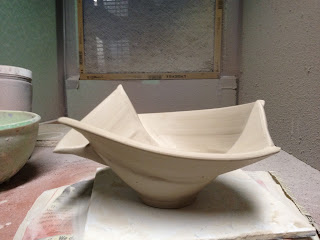No question.
When I am in the middle of a series of pieces, I really have no idea where it will take me, how it will morph into variations of itself, and when I will decide that's all I want to do with that, and move on to something else.
As I said to a colleague recently, my work keeps changing and I go along for the ride. It clearly helps for me to make multiples of the same shape. It is what prompts me to try variations, often when I am not even intending to.
I take photos of my pieces when they are just assembled. Looking at the photograph of a piece often gives me an objective distance that eyeballing it doesn't, like seeing it at a distance with a different pair of eyes to look at the form more critically.
My wife will often be another set of eyes to test against. I show her these photos of what I am working on from time to time. Its easier to get her to look at a photo than to get her away from whatever she's doing (normally its the chickens) and out to the studio to look at the piece. But I digress....
Case in point: I have a process I follow in making (what I call) my triangle bowls, which started out as a variation on my
two sided bowls and
4 sided bowls bowls. I normally cut away sections of the bowl like this;
 |
| incised bowl. top sections are removed, tossed. |
I then remove those top sections, toss them, and end up with the basic triangle bowl:
 |
| newly constructed triangle bowl. |
Last week, sitting down to make 10 of these in a row for upcoming shows, I began looking at the cut-away pieces I was tossing in the reclaim bucket, regretting their loss: I hate losing clay to reclaim whether it is from trimming or from these cut-aways. I wanted to do something with them. With the last 5 pieces, I had had enough of my symmetrical cuts, so I added asymmetrical cuts, still regretting throwing out the cut-ways, but throwing them out anyway . I was ending up with forms more like this:
Finally on the 10th one, unable to resist the urge, I took the cut-away sections, reversed them, and reattached them to the initial form, adding the lip sections used before on top of that, creating a deeper shape than my tried and true shallow triangle bowl shape:
I haven't even fired this one yet. The concern for wasting clay and the urge to use those interesting cutaways joined to provoke me into a new direction.
This is where I am at now-today with the transformation of my triangle bowls. I think there are other forms to alter to, and I am planning on incorporating those once I have made a number of these to see how I feel about them..
For me its usually best to limit the number of variations or alterations in each piece, so as to not miss subtle variations that can really enhance the form. I also have other variations of other shapes which have not run their course which need to be addressed. More on that later...













